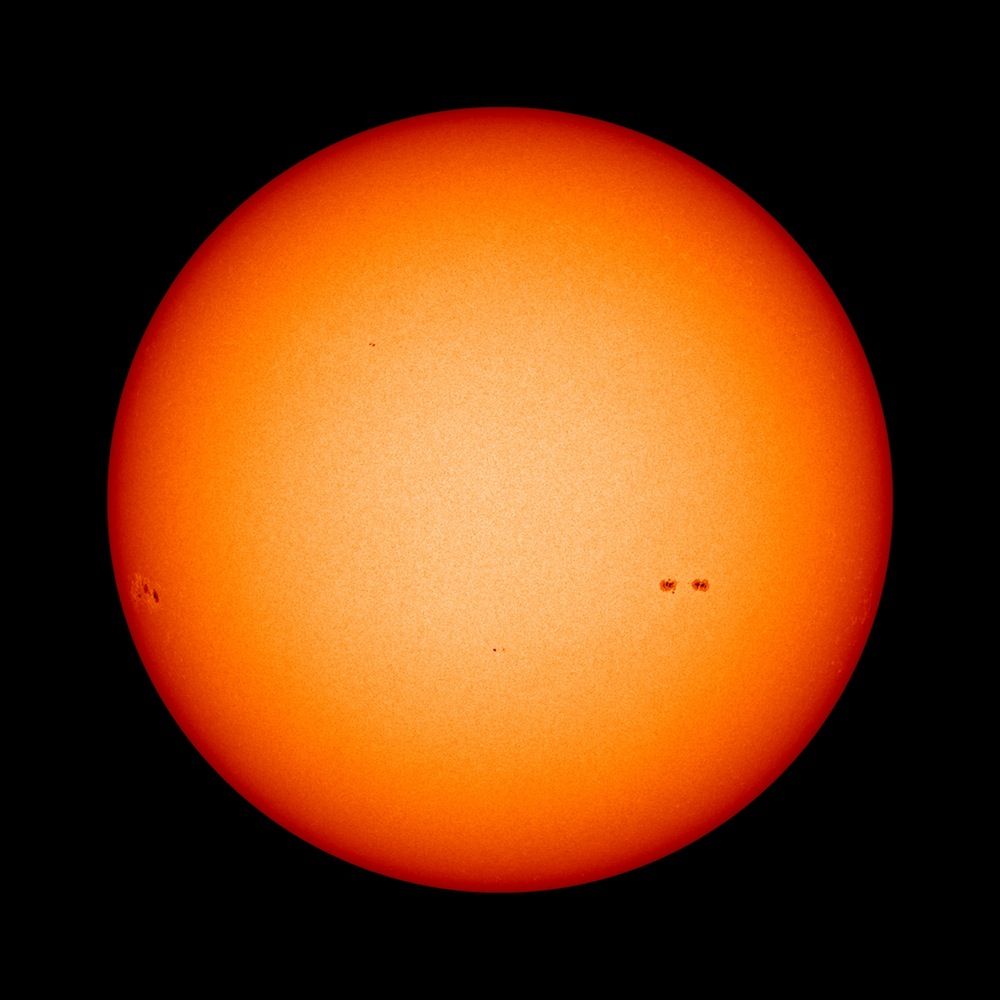Printable Version of Topic
Click here to view this topic in its original format
Unmanned Spaceflight.com _ Sun _ No sunspots
Posted by: alan Dec 29 2007, 09:08 PM
Something you don't see very often: no sunspots
http://umbra.nascom.nasa.gov/images/latest_mdi_igram.gif
most recent sunspot was seen on the 19th
http://www.nwra-az.com/spawx/comp.html
Posted by: nprev Dec 29 2007, 11:04 PM
Well, the last solar max was one helluva max (double-peaked, in fact), so perhaps this solar min will be of equal magnitude. Happy news is that aircraft & maritime navigation systems--specifically, GPS & LORAN-C, to say nothing of HF radio comms-- are lovin' it! ![]()
Posted by: tty Dec 29 2007, 11:24 PM
It does seem as if the sun has a slight hiccup just now:
http://lasp.colorado.edu/sorce/total_solar_irradiance_plots/images/tim_level3_tsi_24hour_3month_640x480.png
Posted by: Canopus Jan 8 2008, 12:19 PM
There were many days of no sunspots in Nov. & Dec. especially; minimum is such a drag. ![]() Spaceweather.com formerly kept track of how many days without 'spots...and then quit giving notice because it'd been so long. That web site gives daily 'spot count, even if it's zero.
Spaceweather.com formerly kept track of how many days without 'spots...and then quit giving notice because it'd been so long. That web site gives daily 'spot count, even if it's zero.
But now we're "over the hump" and Cycle #24 has begun (as per other thread in this folder).
Posted by: Stu Aug 23 2009, 11:02 AM
No sunspots, but a very enjoyable and succesful "Sunwatch" here in Kendal yesterday...
http://cumbriansky.wordpress.com/2009/08/22/eddington-as-sunwatch-a-success
Posted by: Hofi Oct 2 2009, 12:24 PM
Hi!
It seems as the new cycle has just began.
If you have a look at this image from Wikipedia you will see that it is a bit late.
Posted by: dilo Oct 2 2009, 03:45 PM
Hofi, I think the updated image you should link is this one, really showing hints of the new solar cycle:
http://solarscience.msfc.nasa.gov/images/bfly.gif
Indeed, it seems we are returning to less strong activity pattern we had about 1 century ago...
Posted by: tanjent Oct 5 2009, 08:43 PM
Dilo, maybe the astronomers of today can see more of the smaller spots than those of 100+ years ago?
I know the Wikipedia chart is based on the area covered, not the number of spots, but surely there
were a lot more unobserved spots back then, and this must account for some of that (until-recently)
steady increase.
Posted by: PhilCo126 Oct 6 2009, 11:06 AM
A few sunspots appeared but faded away:
http://sites.google.com/site/larrygerstman/the-sun
Posted by: MarsIsImportant Oct 14 2009, 01:11 PM
13 consecutive days without sunspots.
Despite what most thought just a few months ago, apparently the sun has not hit solar minimum yet. This year 79% of the days were without sunspots; last year only 73% of days were with a blank sun.
Posted by: PhilCo126 Jan 15 2010, 10:56 AM
Indeed, the Sun experienced a special period, but it allowed NASA researchers to show a timely link between the Sun and the climate of Earth's thermosphere, the region above 100 km (roughly 60 miles), an essential step in making accurate predictions of climate change in the high atmosphere. Dramatic cooling in Earth’s upper atmosphere correlates with the declining phase of the current solar cycle.
Results obtained through TIMED mission.
(Thermosphere-Ionosphere-Mesosphere Energetics and Dynamics)
Meanwhile, Sunspot 1040 is a sprawling sunspot group.
http://solarcycle24.com/index2.htm
http://www.n3kl.org/sun/index.html
Posted by: Pertinax Jun 16 2011, 12:15 PM
I struggled with resurrecting a dormant thread, but eventually thought that the this the comment is germane and timely.
Interesting S&T article regarding the current and upcoming solar cycles: http://www.skyandtelescope.com/news/123844859.html
-- Pertinax
Posted by: Mongo Mar 8 2013, 08:22 PM
I know that this might be considered thread necromancy, but http://www.wired.com/wiredscience/2013/01/space-photo-of-the-day-2/?pid=6405 is interesting.
Something unexpected is happening on the Sun. 2013 was supposed to be the year of "solar maximum," the peak of the 11-year sunspot cycle. Yet 2013 has arrived and solar activity is relatively low. Sunspot numbers are well below their values from 2011, and strong solar flares have been infrequent.
The image above shows the Earth-facing surface of the Sun on February 28, 2013, as observed by the Helioseismic and Magnetic Imager (HMI) on NASA's Solar Dynamics Observatory. HMI observes the solar disk at 6173 Ångstroms, a wavelength designed to study surface oscillations and the magnetic field. HMI observed just a few small sunspots on an otherwise clean face, which is usually riddled with many spots during peak solar activity.
Posted by: Onlyzen Aug 18 2017, 10:13 AM
Hi Alan,
This link (http://www.moscow-hotels.org/en/nwra-az.html) is not working at my end.
Posted by: jamescanvin Aug 18 2017, 11:36 AM
The post you are talking about is nearly 10 years old! It's not too surprising that some links are broken and now redirect to something else entirely.
Posted by: JRehling Aug 20 2017, 08:43 PM
FYI, it's not only the Internet that's changed; so has the Sun. As of yesterday, there's a beautiful sunspot group, and hopefully, a lot of people notice that during the partial phases of tomorrow's eclipse.
Posted by: JohnVV Aug 22 2017, 11:22 PM
soho as of today
https://sohowww.nascom.nasa.gov/data/synoptic/sunspots_earth/mdi_sunspots_1024.jpg
---
https://sdo.gsfc.nasa.gov/data/
and
http://sidc.oma.be/
Powered by Invision Power Board (http://www.invisionboard.com)
© Invision Power Services (http://www.invisionpower.com)